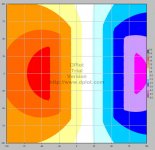Patrick Johnson said:
If I understand Joey, he's saying that hitting below center lifts the CB some, reducing immediate ball/cloth friction and causing the CB's curve to stretch out (as if the cloth is slicker) compared with hitting above center. I think this is a plausible idea.
I also think that the opposite effect occurs: hitting above center forces the CB down into the cloth during tip contact, increasing immediate ball/cloth friction and causing the CB's curve to shorten (as if the cloth is stickier) compared with hitting below center. This is very noticable when hitting even more downward, such as when the CB is frozen to the rail.
I think these differences together can account for a noticable increase in swerve effect when hitting above center compared with hitting below center.
Patrick, I think most of the effect is due to the amount of relative surface speed available, in a manner of speaking, and the direction of that surface speed.
With a sphere sliding on a fixed surface (cloth/bed), 2/7'ths of the initial relative surface velocity, which has both magnitude and direction (ie, it's a vector quantity) is subtracted vectorally from the sphere's initial translational velocity, which also has magnitude and direction, during the process of reaching natural roll.
In the case of a high hit with english, there is relatively little surface speed in magnitude, but its direction is more sideways. Thus, you get a more immediate swerve effect because of the direction, but the final swerve angle is less because of the smaller magnitude.
In the case of a low hit with english, the magnitude of the relative surface speed is larger, but its direction is less sideways and more in line with the sphere's initial direction. Here you end up with a greater overall swerve angle if the ball is allowed to reach natural roll before colliding, but the effect is not as immediate because of the direction of the surface speed. So with many draw shots you don't see that much swerve because natural roll isn't achieved before the collision, and the swerve takes place at a more leisurely pace.
The bouncing you described no doubt adds to this, but I think the major difference is due to the surface speed stuff described above. A ball that is just slightly bouncing acts pretty much like a ball that is sliding uniformly on the cloth. (But I can't say that I've done a quantitative comparison for specific cases.)
In the case of a ball/ball collision (ie, no fixed surface), and where the balls reach "natural roll" across each other during the collision, 1/7'th, as opposed to 2/7'ths, of this initial relative surface velocity adds vectorally to the object ball's velocity (initially zero of course), and is likewise subtracted from the cueball's post-impact velocity. The horizontal component of this is the OB's throw velocity. It's reduced to 1/2 here because the object ball can both move and spin and is physically identical to the cueball (ideally), and thus kindly (or maybe unkindly) takes up half of that 2/7'ths.
(Hope this adds to any confusion - it sure has helped mine. Dr. Dave illustrates these swerve effects in at least one of his articles.)
Jim
